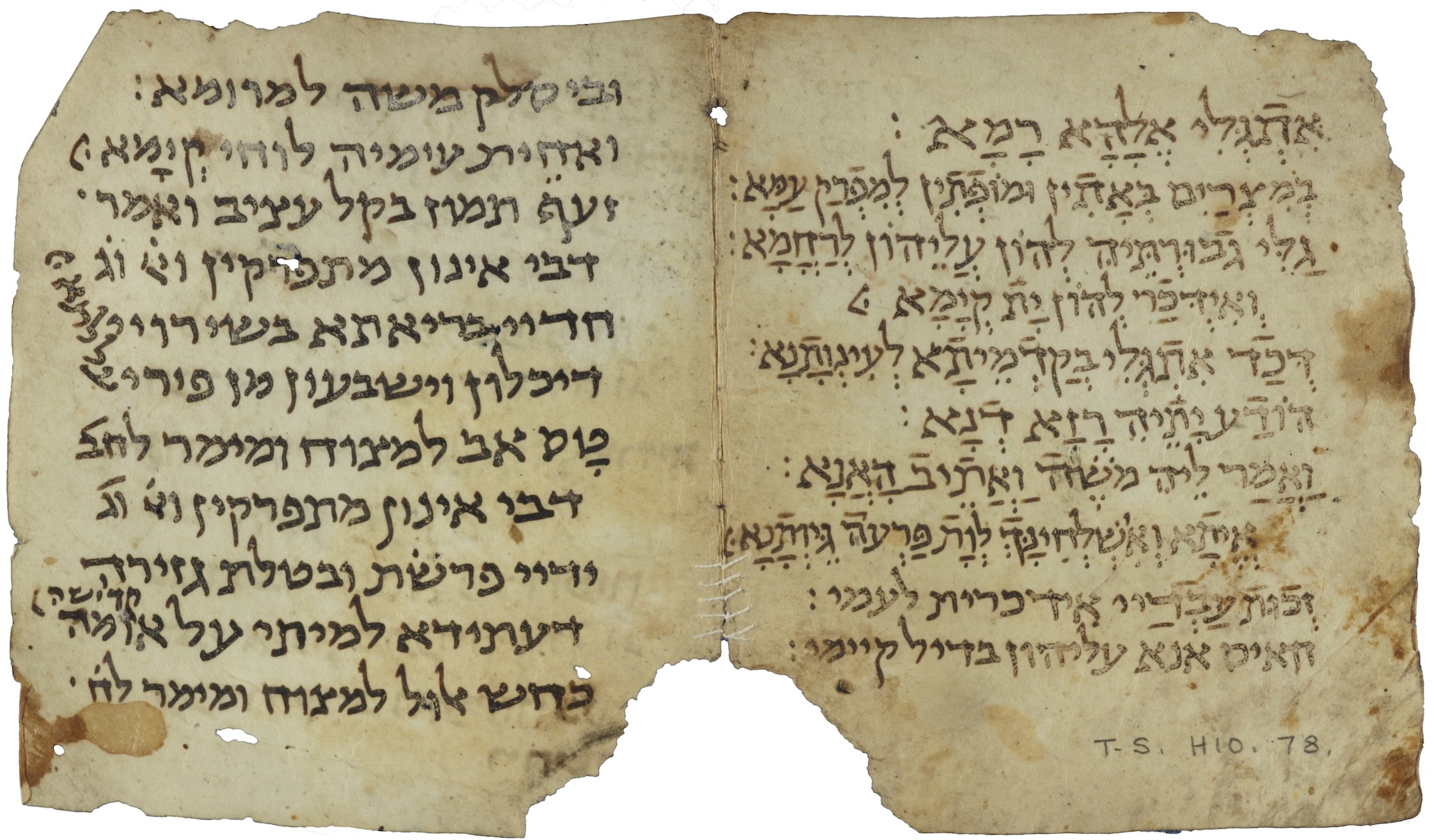Throwback Thursday: Targumic poems of the Pentateuch

T-S H10.78: The twelve months debate their relative importance.
Thu 18 Nov 2021
Our Throwback Thursday this week is taken from issue 11 of the printed edition of Genizah Fragments, published in April 1986, by Michael Klein:
The Cairo Genizah has proved to be a unique kaleidoscope of mediaeval Jewish society. Its many thousands of manuscript fragments have shed light on almost every aspect of Jewish life in the Mediterranean basin. The texts and documents reflect both the sacred and mundane realms of daily life. In the synagogal domain, new liturgical customs and texts have become known. Among these are manuscripts of the various targumim, the ancient translations of the Hebrew Bible, that were read in the synagogue alongside the Hebrew text. For several centuries before and after the Common Era, Hebrew was no longer understood by the masses and had to be translated into the Aramaic vernacular. Similarly at a later stage, in the early Islamic centuries, when Aramaic was forgotten, there emerged Judaeo-Arabic translations of the Pentateuch – the most famous of them by Saadya Gaon. But the Aramaic targumim, having been attributed by the rabbis of the Talmud to Ezra the scribe and having been further sanctified by centuries of use in the synagogue, refused to yield their position of prestige. Instead, there emerged a new trilingual Bible manuscript composed of Hebrew, Aramaic and Arabic, verse by verse. There are, in fact, hundreds of fragments of this genre in the Cambridge Genizah Collections, in which the Aramaic is that of Onqelos, and the Arabic is Saadya's. My personal interest over the past decade has been in the Palestinian Targumim of the Pentateuch, and this has brought me in recent years on four visits to the Taylor-Schechter Unit. From among the 230 pages of text collected, more than 130 are from Cambridge (the others being mainly from Oxford, the Jewish Theological Seminary in New York, and Leningrad). The Palestinian Targumim are of particular interest because they are not merely literal renderings of the Hebrew Bible into Aramaic. Indeed, they often interpret and elaborate upon the Biblical text. They frequently contain lengthy midrashic passages (toseftoth) embroidered upon the terse Hebrew narratives about the patriarchs. For example, they explain how Cain and Abel, the only two reported children of Adam and Eve, were actually born with twin sisters – so that they might have women to marry. Each married the other's twin (in order to minimize the incest); and this was also the source of their deadly dispute. The Palestinian Targumim explain how the dying patriarch, Jacob, had wanted to reveal to his twelve sons the esoterical "End of Days" – but, alas, no sooner had it been revealed to him than it was concealed again. The manuscripts of Palestinian Targum also include many introductory poems written in the same dialect (Galilean Aramaic) as the Targum itself. These poems were recited in the synagogues on festivals and special Sabbaths prior to the Torah reading. There are poems, for example, that describe the debate among the twelve months to determine in which of them Israel will be delivered from Egypt. Such verses were recited on the Sabbath nearest the new moon of Nisan. Nisan argues that Iyyar cannot be chosen, since its zodiacal sign is Taurus, and the golden calf that Israel made in the wilderness was a young ox. And so on. Another targumic poem, read on the seventh day of Passover, tells of how the sea refused to split before Moses, angrily saying "I shall not be vanquished by one born of woman" Yet another beautiful poem tells with great pathos how Moses refused to accept his mortal destiny. He goes to Hebron, where he awakens Adam from his eternal rest. He blames him for sinning in the Garden of Eden, and thereby bringing death upon all mankind – Moses included. But Adam cleverly quotes the midrash which states that the Torah was written 2,000 years before the creation of the world. The mortality of man was, therefore, predestined. Moses sheds a tear and accepts his inevitable lot. The Palestinian Targumim from the Genizah have long been recognized as one of the most important sources for the study of Galilean Aramaic. Christian scholars have sought in these texts the Aramaic dialect that was spoken by Jesus, and in which his sayings and quotations from the Jewish Scriptures were originally transmitted. The Palestinian Targumim have also been a source of early non-normative interpretations of legal passages in the Pentateuch. They frequently preserve an exegesis that runs counter to what later became the accepted halakhah (religious law) as found in the Mishnah and Talmud. This is a subject that deserves further attention. Finally, the ancient Palestinian rite followed a triennial lectionary cycle, i.e., completing the reading of the Pentateuch every three years, or twice every seven years - in contrast to the Babylonian annual cycle that is followed to this day in all traditional synagogues. The manuscripts which were used in synagogues contain signs and ciphers marking the respective triennial sidroth (weekly readings). They also record the haftaroth (readings from the prophets) in many instances. All this information has been valuable in the reconstruction of the rite of the ancient Palestinian synagogue. The orderly and systematic study of the above-mentioned subjects in targumic and related studies has to a very large degree been made possible by the meticulous and unparalleled labours of conservation and cataloguing of the Taylor-Schechter Genizah Unit. Under the leadership of Dr Stefan Reif, the Unit has made accessible to scholars of Hebraica and Judaica the great treasures of the Cairo Genizah.
Add new comment